ISSN ONLINE(2278-8875) PRINT (2320-3765)
ISSN ONLINE(2278-8875) PRINT (2320-3765)
| S. Yang Assistant professor, Department of EE and CS, Alabama A & M University, Huntsville, Alabama, USA |
| Related article at Pubmed, Scholar Google |
Visit for more related articles at International Journal of Advanced Research in Electrical, Electronics and Instrumentation Engineering
A compact microwave bandstop filter (BSF) with high rejection is proposed. This filter combines a conventional two open stubs BSF and asymmetrical double spurlines. Simulations show this BSF has a wider and a deeper stopband without increasing circuit size, compared with the conventional BSF. This BSF is used to suppress the first harmonics of a parallel coupled banpass filter (BPF). Simulations show deeper suppression compared with the application of a conventional BSF.
Keywords |
| Asymmetrical Double Spurlines, Bandstop Filter, Harmonic Suppression. |
INTRODUCTION |
| Microwave bandstop filters (BSFs) are being widely used in telecommunication systems. Various techniques have been developed to design and synthesis BSFs [1]. Conventionally, by cascading more open stubs onto a microstrip, a wider rejection bandwidth and a deeper rejection can be obtained. The side effects of this method are the high insertion loss in the passband and increased circuit size [2-3]. In this paper, a microstrip BSF with two open stubs and asymmetrical double spurlines is presented. By inserting asymmetrical double spurlines between the two open stubs, wider rejection bandwidth and deeper rejection can be achieved without increasing the overall circuit size. The proposed BSF is simulated and then is used to suppress the first harmonics of a BPF |
II. RELATED WORK |
| A conventional open stubs BSF can be formed by mounting two open stubs onto a microstrip. The length of the two stubs and the separation between the two stubs are a quarter of the wavelength at the midband frequency [2]. Spurline was proposed by Bates to generate bandstop filters (BPFs) [4]. A spurline is realized by etching an L-shaped slot on a microstrip. Asymmetrical double spurlines were proposed by Liu, Cao, and Shi to form a dual-bandgap BSF [5]. Double spurlines are formed by etching two spurlines at the two sides of a microstrip. Liu, Tong and Li have used asymmetrical double spurlines to suppress two harmonics of a microwave amplifier [6]. The proposed BSF is a combination of a conventional BSF and asymmetrical double spurlines. |
III. FILTER LAYOUTS AND SIMULATION RESULTS |
| Fig.1 shows the configuration of a conventional open stubs BSF. The substrate material is Rogers TMM10i with a relative dielectric constant of 9.8 and a loss tangent of 0.002. The thickness of the substrate is 1.27 mm. The whole backside of the substrate is the ground plane. The width of the feed line and the open stubs is 1.2 mm, which gives a characteristic impedance of 50 Ohm. The two open stubs are 5.86 mm long and the separation between them is also 5.86 mm. |
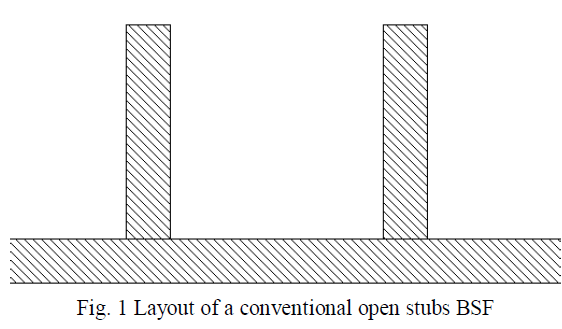 |
| This conventional BSF is simulated on Sonnet Suite 14.52. The mesh size is chosen as 0.01 mm by 0.01 mm. Sonnet Suite is a 3D planar EM software based on Method of Moments. Simulation results on return loss S11 and insertion loss S21are shown in Fig. 2. The midband frequency is at 4.9 GHz. The deepest rejection is about 32 dB. |
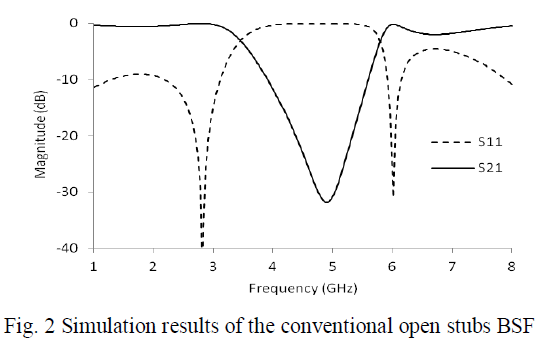 |
| Asymmetrical double spurlines on the substrate mentioned above are shown in Fig. 3. The width of the microstrip is 1.2 mm. The dimensions of the short spurline are width 0.3 mm, length 5.66 mm and gap 0.1 mm. The dimensions of the long spurline are width 0.2 mm, length 6.86 mm and gap 0.1 mm. The short spurline is wider than the long spurline. |
 |
| This pair of asymmetrical double spurlines is simulated on Sonnet Suite. The mesh size is also set at 0.01 mm by 0.01 mm. The simulation results are shown in Fig. 4. This double spurlines generate two attenuation poles at two frequencies. The attenuation pole at 5.32 GHz, generated by the short spurline, is 34 dB deep. The other attenuation pole at 4.48 GHz, generated by the long spurline, is 33 dB deep. |
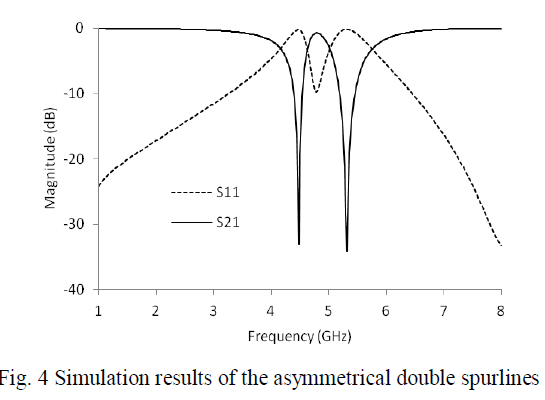 |
| The proposed BSF is a combination of the conventional open stubs BSF and the asymmetrical double spurlines. The asymmetrical double spurelines are inserted between the two open stubs of the conventional BSF. Layout of this BSF is shown in Fig. 5. All the dimensions in this layout have been mentioned early. |
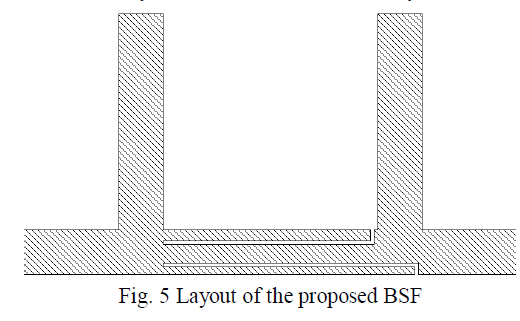 |
| The proposed BSF is simulated on Sonnet Suite. The insertion losses of the proposed BSF and the conventional BSF are shown together in Fig. 6 for comparison. The asymmetrical double spurlines generate two attenuation poles at the two sides of the midband frequency. The proposed BSF has wider rejection bandwidth and deeper rejection capability. Its 20 dB rejection band is from 4.18 to 5.60 GHz. Its 30 dB rejection band is from 4.62 to 5.26 GHz. The deepest rejection reaches -36 dB. |
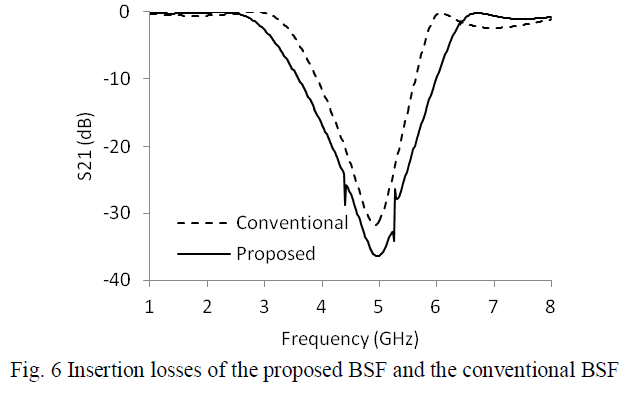 |
IV. FIRST HARMONIC SUPPRESSION OF A BANDPASS FILTER |
| The proposed BSF is connected to the output of a third order parallel coupled BPF [7] to suppress its first harmonics. The layout is shown in Fig. 7. This kind of BPF consists of a bunch of parallel line pairs. Microwave signals are coupled between these paired lines. The length of these line pairs is a quarter of the wavelength at the midband frequency. The design of this filter is through the calculation of even-mode and odd-mode characteristic impedances of coupled line pairs and the computation of physical dimensions of these line pairs [7]. This BPF has a midband frequency of 2.45 GHz and a bandwidth of 200 MHz. |
 |
| This parallel coupled BPF has a passband around 2.45 GHz and a first harmonics around 4.9 GHz. The whole filter is simulated again on Sonnet Suite. The simulation results are shown in Fig. 8. The first harmonics around 4.9 GHz is highly suppressed for more than 33 dB. At the same time, the insertion loss in the passband does not get much disturbance. For comparison, the insertion losses of the original BPF, and the whole filter with conventional and the proposed BSFs are shown together. The proposed BSF has better performance than the conventional BSF on the first harmonic suppression. |
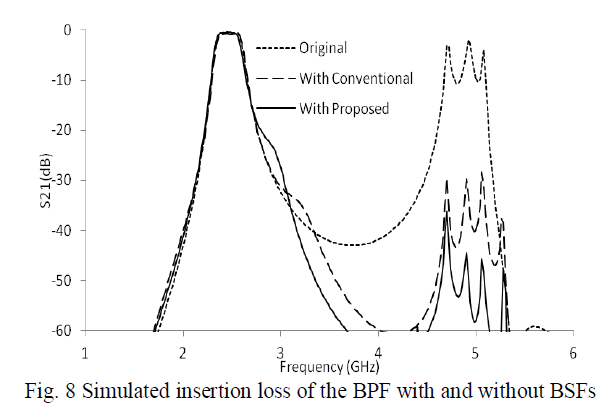 |
V. CONCLUSIONS |
| A pair of asymmetrical double spurlines is inserted between the two open stubs of a conventional BSF to form a novel BSF. The proposed BSF is simulated on Sonnet Suite software. Simulation results show the proposed BSF has a wider rejection bandwidth and deeper rejections compared with the conventional BSF. This proposed BSF is also used to suppress the first harmonics of a parallel coupled BPF. Simulation results show the first harmonics is suppressed more compared with the application of a conventional BSF. |
ACKNOWLEDGMENT |
| The author would like to thank Dr. Montgomery for his financial help, Dr. Scott for his help to install Sonnet Suite software, and Dr. Heidary for his microwave network analyzer. |
References |
|